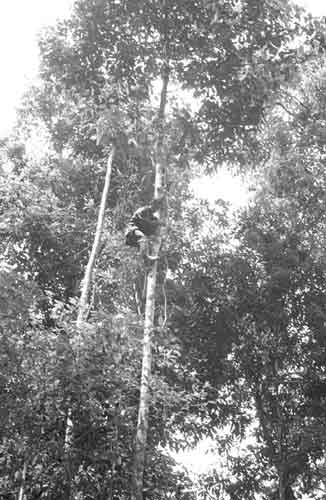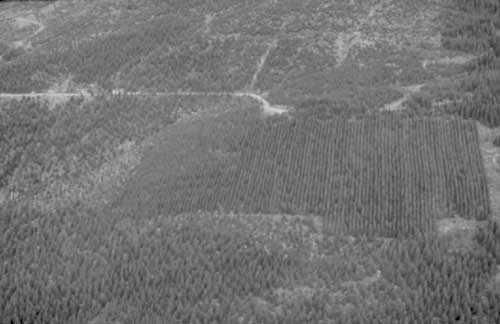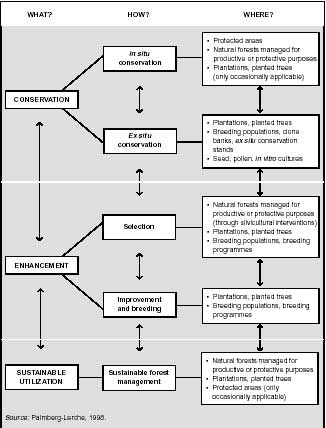Christel Palmberg-Lerche is the
Chief of the Forest Resources
Development Service, Forest
Resources Division, FAO Forestry
Department, Rome.
Considerations for effective conservation of forest genetic resources, based on two underlying principles: nothing in nature is static; and forests and the genetic resources they contain, if properly managed, are renewable.
Forest managers are increasingly aware of public and regulatory concerns about biological diversity, and are responding to them (FAO, 2002; Libby, 2000). This article underlines some fundamental, but sometimes overlooked, ideas about genetic resources conservation in forestry - particularly the need to recognize both the production and environmental values of forests; and the recognition that human intervention in nature is not always negative.
Elaborating on these thoughts, the article explores some considerations for effective conservation of forest genetic resources, including the need for close links among conservation activities carried out at various levels, local, national, regional and international; the need to manage resources targeted for conservation in several locations, under varying environmental conditions and silvicultural regimes; and means of increasing awareness of genetic resources issues at all levels in order to promote improved conservation strategies.
Forests and trees have great emotional and spiritual value in most societies. The ecosystems that they support have intrinsic environmental values in conserving soil and water, providing shelter and food for wildlife and a habitat for other species, and meeting recreational, aesthetic and spiritual needs. In addition to these services, the products derived from trees - wood, timber, fruits, fodder, resins, gums, dyes and the like - have considerable value, both economic and social. This is in contrast to agriculture in the narrow sense; a field of wheat has socio-economic value, but its environmental values are minor or non-existent.
A balanced view is needed of the value of forests as for their environmental functions, and the value of wood and non-wood products derived from trees and forests.
When such a balanced view is not present, or when the issue is simply not understood, friction and clashes result - such as those sometimes seen among representatives of the decision-making level or representatives of forest industry on the one side, preoccupied with early revenue and the end product of forests; and, on the other side, popular movements highlighting only the environmental value, or one of the environmental values, such as for example biological diversity or the maintenance of the habitat of one species or group of species.
Priorities in the sustainable management of forests, including the conservation of forest biological diversity at the levels of ecosystems, species and genetic resources, will depend on value judgements and the relative emphasis on the various roles and functions of forests. It is clear that dialogue and the involvement of all stakeholders and interested parties is of utmost importance to reach balanced decisions and ensure that action programmes for genetic conservation will be generally accepted and thus sustainable in the long term.
In current popular discussions it is often assumed that there are relatively few ultimate causes of threat to diversity. It is also frequently thought that any intervention by humans will be destructive. If this were true, the problem would have to be solved by withdrawing all human intervention, or by segregating land uses into strict, separable compartments.
There are many myths related to forests. Among the popular myths to be dispelled as soon as possible are those related to the belief that nature is static and that lack of human intervention will ensure a status quo in ecosystems; that the present state of diversity is the ideal one; and that human action is a threat which can only diminish, never help maintain or enhance, genetic diversity (see Eriksson, Namkoong and Roberds, 1993; Palmberg-Lerche, 1990).

Collection of material for genetic resources conservation, Brazil
- L. PROCÓPIO
The management of biological diversity at the levels of ecosystems, species, populations, individuals and genes is a diverse task. Problems and solutions will differ according to variables such as:
Solutions will further vary according to the type and intensity of human use of the resources and the products available from them.
Finally, and decisively, solutions will depend on prevailing legal and policy frameworks, levels of institutional support and stability, institutional capacities to tackle the task in a technically sound, economically feasible and socially acceptable manner and levels and continuity of funding for shouldering related responsibilities.
Genetic management and conservation programmes need to be based on solid, technically and scientifically sound information. In the short term, however, action in genetic management should not await ultimate scientific responses, but should start immediately, using the best available information and common forestry sense, applying flexible strategies into which new knowledge can be incorporated when and as it becomes available.
The technical and scientific challenges often absorb most of the attention of technical staff. But complementing these challenges there is a need and an obligation to inform politicians, decision-makers and the public at large of the strategies and methodologies available to respond to the challenges of conservation and genetic management, of the priorities and of the likely consequences of inaction. Adequate understanding of such issues is a prerequisite for much-needed support at all levels, including support at the national policy-making level, which in turn is essential for institutional support and sustained funding.
There is no simple single strategy for genetic conservation, applicable to all situations. When planning action in genetic management it is important to review and consider the levels of attention and types of action which should be targeted. National programmes, based on national and local needs, provide the basic building blocks for any action in forest genetic resources. At the same time they have a number of limitations. The natural distribution of many forest tree species crosses political borders. Furthermore, a number of species and provenances are of little current importance in their countries of origin, while they may have become socially or economically important outside their natural ranges. Collaboration between two or more countries is therefore frequently necessary to ensure complementarity of action at the regional and at international levels.
Regional and subregional action programmes, while building on national plans, can in turn provide a point of reference and useful feedback to national activities in genetic conservation. Common agreement on principles that determine priorities for specific conservation-related activities, and dialogue on optional strategies and methodologies, will help strengthen the impact and effectiveness of national activities. Regional and international attention and collaboration at these levels can frequently also provide a strong, additional argument which can be used in convincing policy and decision makers of the importance of issues and the need for action at the national level.
Subregional and regional action programmes can later, if countries so wish, be placed within a larger context, contributing to a comprehensive, global action framework (see Palmberg-Lerche, 1997; Palmberg-Lerche and Hald, 2000; Sigaud, Palmberg-Lerche and Hald, 2000; FAO, 2001).
Links and dialogue among actors at the various levels is an unqualified must, as are intersectoral considerations and collaboration and support for exchange of information and expertise at all levels.
While development of methodologies and research is best supported at the national and local levels, there are challenges that can, with advantage, be met at the regional, ecoregional and, at times, international levels. Activities above the national level can frequently help make the best use of scarce resources and avoid wasteful overlap of efforts.
Similarly, most action in field testing and pilot programmes is taken at the national and local levels, although some work can be done at the regional level. Here the role of international agencies and institutions is less prominent, and focuses on technical support rather than operations.
Implementation of conservation strategies in the field is primarily done at the national and local levels, although some action can be carried out at the regional level. Progress depends on commitment within countries, involving policy-makers, technical staff and other stakeholders. International agencies and institutions like FAO can help raise awareness of needs, help propose strategies and methodologies and help build capacity - but they can never do the actual conservation. It is important for countries to recognize this, and to plan accordingly.

Field trials (shown here, coastal Douglas fir, Pseudotsuga menziesii, in Canada) can serve as ex situ conservation populations
- FAO FORESTRY DEPARTMENT/C. HEAMAN
How can forestry professionals increase awareness at all levels of the need for genetic management and make it happen, or happen more vigorously than at present? Among principles to remember are:
There will invariably be a need to use a range of strategies, means and methods and to draw upon a range of institutions, which may often have totally different philosophies, approaches and immediate aims. Continuing dialogue is therefore essential.
There will be a need to take stock of progress at regular intervals and to adjust action, applying forward-looking strategies and plans. Adjustments should build on experiences gained and on new and enhanced knowledge. They should also take into consideration a due gradual increase in policy-level awareness, likely to be reflected in increased institutional support and resource allocation.
An important consideration, and a basis for successful action, is acknowledgement that national policies related to forest biological diversity and forest genetic resources cover a range of activities, from conservation measures to protect rare and endangered species and populations, to regulations governing seed collection and transfer in socio-economically important tree species, to comprehensive approaches to the management of landscapes, ecosystems and forest genetic resources. All of these fields of activity have a role, and the parts of this puzzle must be pieced together to form a coherent, mutually supportive strategy for action in forest genetic resources.
The management of an appropriate combination of resource areas, in various locations and under diverse environmental conditions and silvicultural regimes, is likely to be the most efficient way to conserve diversity and genetic variation of forest trees.
Strategies for what Wilcox (1990; see also Wilcox, 1995) referred to as "incorporation of conservation concerns in a mosaic of land use options" include incorporating genetic resources considerations into the management of:
Genetic conservation ex situ can also involve conservation as seed, pollen and tissue, complemented by material maintained in breeding populations (see Figure).

Management of genetic resources of forest trees and shrubs: concept and components
The late Abdou Salam Ouédraogo, Senior Forest Genetic Resources Officer at the International Plant Genetic Resources Institute (IPGRI), frequently repeated the words of a Minister of Forests in his native Burkina Faso, who after attending a number of sessions in an FAO/IPGRI forest genetic resources workshop in the mid-1990s noted: "I thought that conservation of forest genetic resources was complex and was going to be difficult to understand, but I now see that such conservation, in fact, refers to what we are doing every day!"
Maybe here lies the secret of gaining increasing levels of attention and support and meeting the challenges inherent in the abstractions referred to as "political awareness" and "political will", which ultimately underpin availability of supporting legislation, policies, institutions and commitment in the short, medium and long terms: what is needed is to ensure that stakeholders and collaborators, at all levels, understand that conservation is an everyday concern - not necessarily complex and technically difficult, but essential if nations are to ensure sustainability in forestry, in agriculture and in overall national and local development.
Bibliography
Eriksson, G., Namkoong, G. & Roberds, J.H. 1993. Dynamic gene conservation for uncertain futures. Forest Ecology and Management, 62: 15-37.
FAO. 2001. Regional strategies and action plans on forest genetic resources. Forestry Department Information Note. Rome. Available on the Internet: www.fao.org/forestry/FODA/Infonote/en/t-rgst-e.stm
FAO. 2002. Forest plantation productivity. Forest Plantation Thematic Papers, Working Paper No. 3. Rome.
Libby, W.J. 2000. Strategic directions in utilizing genetic resources. In Genetic resource management - building strategies for the new millennium. Proceedings of the 27th meeting of the Canadian Tree Improvement Association, Part II, Symposium, p. 6-19. Sault Ste Marie, Canada, 15-17 August 2000.
Palmberg-Lerche, C. 1990. Conservation and management of forest genetic resources. Journal of Tropical Forestry Research, 11(1): 286-302.
Palmberg-Lerche, C. 1997. Towards a coherent framework for the conservation and sustainable utilization of forest genetic resources. Forest Genetic Resources, 25: 15-18.
Palmberg-Lerche, C. 1998. Management of forest genetic resources: some thoughts on options and opportunities. Forest Genetic Resources Information, 26: 45-46.
Palmberg-Lerche, C. & Hald, S. 2000. Management of forest genetic resources: status and challenges. Unasylva, 203: 27-33.
Sigaud, P., Palmberg-Lerche, C. & Hald, S. 2000. International action in the management of forest genetic resources: status and challenges. In B. Krishnapillay, E. Soepadmo, N. Arshad, A. Wong, S. Appanah, S. Chik, N. Manokaran, H. Tong, H. & K. Choon, eds. Forests and society, the role of research. XXI IUFRO World Conference, Vol. I, p. 91-99. Kuala Lumpur, Malaysia, 5-12 August 2000.
Wilcox, B.A. 1990. Requirements for the establishment of a global network of in situ conservation areas for plants and animals. Rome, FAO. (Unpublished paper.)
Wilcox, B.A. 1995. Tropical forest resources and biodiversity: the risks of forest loss and degradation. Unasylva, 181: 43-49.
* This article is adapted from an intervention at the International Plant Genetic Resources Institute (IPGRI)/Austria Training Course on Conservation and Management of Forest Genetic Resources in Eastern Europe, organized in collaboration with FAO, in Gmunden, Austria, 29 April to 12 May 2001.